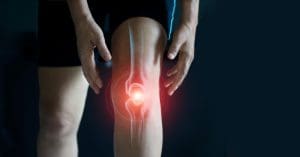 While there’s no cure for arthritis knee pain, physical activity and topical treatments may help relieve pain and promote mobility in the joint. Continue reading below to learn more about what you can do from home to alleviate arthritic knee pain.
While there’s no cure for arthritis knee pain, physical activity and topical treatments may help relieve pain and promote mobility in the joint. Continue reading below to learn more about what you can do from home to alleviate arthritic knee pain.
Arthritis causes inflammation in one or more joints. Pain, swelling, stiffness, and tenderness are the main symptoms of arthritis. Any joint can be affected by arthritis, but the knee is the most commonly affected joint. The two common arthritis causes of knee arthritis are osteoarthritis (OA) and rheumatoid (RA), but arthritis comes in more than 100 forms and any of these can affect your knees.
Knee arthritis can be painful and affect your ability to walk or climb steps. And research shows it is a major contributor to both disability and time lost from work. Although there is no cure for knee arthritis, there are treatments available to help you to keep moving. In addition to treatments your doctor provides, there are ways you can treat knee arthritis at home.
Physical Activity
Exercise can help improve your health without hurting you. And exercise has many benefits, including:
- Strengthening the muscles around the joints
- Maintaining your bone strength
- Giving you more energy
- Helping you to keep a healthy weight
- Making it easier to sleep at night
- Improving your balance
- Enhancing your life quality
Exercise will and should help you without aggravating your joints or making pain and other arthritis symptoms worse. But lack of activity can actually make your joints hurt more. Not exercising can weaken the muscles around joints, which creates more stress on the joints. A 2019 review of studies aimed to evaluate the effects of exercise, physical function, quality of life as it pertained to overall health, co-comorbid conditions (coexisting diseases), and OA structural disease progression in people with OA of the knees or hips.
The report’s authors found that physical activity decreased pain, strongly improved physical function, and moderately improved health-related quality of life in people living with hip or knee OA in comparison to adults with these arthritic conditions who were less active. The study also found that in some cases improvements continued for up to six months following the end of an exercise program. The report’s authors concluded people with lower extremity OA should be encouraged to engage in as much physical activity as they can regardless of how minimal that might be.
They further suggested that any type of activity can help with gaining health and arthritis-related benefits. Different types of exercise can help you with improving knee pain, including low impact cardio activities, strengthening and stretching exercises, and tai chi.
Low-Impact Cardio
 Low impact cardio exercise increases your heart rate while minimizing impact or stress on your joints. These types of exercise allow you to benefit from cardio exercise without hurting your joints. Low impact cardio exercises include things like walking, biking, and elliptical training. How low-impact exercise fits into your life is up to you. For example, you may want to walk every day for a half-hour during your lunch hour, or maybe, you want to ride your bike early in the morning for an hour, three to four times a week. Set a goal to just keep moving.
Low impact cardio exercise increases your heart rate while minimizing impact or stress on your joints. These types of exercise allow you to benefit from cardio exercise without hurting your joints. Low impact cardio exercises include things like walking, biking, and elliptical training. How low-impact exercise fits into your life is up to you. For example, you may want to walk every day for a half-hour during your lunch hour, or maybe, you want to ride your bike early in the morning for an hour, three to four times a week. Set a goal to just keep moving.
Low-intensity exercise, where your heart rate is not raised, may also be beneficial. A 2015 systemic review of studies suggests low-intensity exercise can be effective in improving physical and cognitive health in older adults. They also found improvements in flexibility, balancing, lower limb muscle strength, and depressive symptoms. If experience unusual pain while exercising, stop doing the activity that is causing it and call your doctor.
Strengthening Exercises
Strengthening exercises are ones that help build strong muscle, which you need to support and protect your joints. According to the American Academy of Orthopaedic Surgeons, you can reduce stress on your knee joints by regularly working out the muscles around the knees. This includes exercises that work the hip muscles, glutes, hamstrings, quadriceps muscles. Examples include lifting weights, push-ups, sit-ups, squats, and working with resistance bands. Many benefits can be gained from strengthening exercises, including increased muscle strength, a reduced risk for injuries, improved function and movement, and even a delayed onset of arthritic damage. You shouldn’t feel any pain as you do your strengthening exercises. Talk to your doctor or a physical therapist if you find yourself experiencing pain while exercising your muscles and joints.
Stretching
 Warm-up stretching exercises can help you get your body ready for strenuous activity. Stretching can also make it easier to exercise. Harvard Medical School recommends stretching exercises before and after aerobic or strength training exercises.
Warm-up stretching exercises can help you get your body ready for strenuous activity. Stretching can also make it easier to exercise. Harvard Medical School recommends stretching exercises before and after aerobic or strength training exercises.
There are many benefits to stretching, especially for your lower extremities. These include:
- Improved range of motion
- Decreased muscle tension
- Reduced risk for muscle or soft tissue injury
- Improved synovial fluid—the fluid found in the cavities of synovial joints
Tai Chi
Tai chi is an ancient Chinese practice that can be best described as a graceful form of exercise. It involves gentle exercise and stretching, where each movement flows into the next to ensure the body stays in constant motion. Studies on tai chi for managing knee arthritis suggest it can relieve knee OA symptoms. One study reported in 2016 in the journal revealed that tai chi can be just as effective as physical therapy for managing knee OA. In this study, participants with OA took a tai chi class or went to physical therapy twice a week.
After three months, both groups were experiencing similar improvements, including improved physical function, reduced pain medication use, and improved quality of life. In addition, the people who did the tai chi seemed to have more improvements in quality of life and less depression. The best way to learn and practice tai chi correctly is with an instructor. Look for a class at your local fitness center or ask your doctor or physical therapist for a recommendation. You may want to watch a class first before you commit. You should also check with your doctor to see if tai chi is safe for you to do, as you would with any type of exercise program.
Diet
As you try to tackle your knee pain, don’t overlook the importance of a healthy, well-balanced diet. And while there is no specific diet for managing your knee pain, eating smart can help you to keep weight under control and reduce inflammation and pain.
Weight Management
 Maintaining a healthy weight can be beneficial to your knee joints. This is because there is reduced stress on your knees. And according to the American College of Rheumatology and the Arthritis Foundation, losing 5% or more of your body weight can have positive effects on your knee function and treatment outcomes. Another problem with being overweight is that fat itself creates and releases pro-inflammatory chemicals. By reducing weight, the level of inflammation in your body would be reduced. A 2018 article published Frontiers in Medicine explained how being overweight can cause the body to activate and sustain inflammation. This type of inflammation can worsen an autoimmune disease like RA. More inflammation means more knee joint pain.
Maintaining a healthy weight can be beneficial to your knee joints. This is because there is reduced stress on your knees. And according to the American College of Rheumatology and the Arthritis Foundation, losing 5% or more of your body weight can have positive effects on your knee function and treatment outcomes. Another problem with being overweight is that fat itself creates and releases pro-inflammatory chemicals. By reducing weight, the level of inflammation in your body would be reduced. A 2018 article published Frontiers in Medicine explained how being overweight can cause the body to activate and sustain inflammation. This type of inflammation can worsen an autoimmune disease like RA. More inflammation means more knee joint pain.
A healthy weight can also your risk for a variety of serious health conditions, like diabetes and high blood pressure. And high levels of inflammation in your body can add another layer of risk for you. In addition to reduced pain, inflammation, and reduced risk for other serious health conditions, the Arthritis Foundation reports on additional benefits to weight management.These include:
- Reduced disease activity: Losing weight can reduce the overall severity of the disease, especially in inflammatory arthritis.
- Increased potential for remission: Remission, as it relates to inflammatory arthritis like RA, means little or no disease activity. The Arthritis Foundation reports on several studies showing being overweight reduces the chance of “achieving minimal disease activity or remission” in people who have rheumatoid arthritis or psoriatic arthritis.11
- Slowed cartilage degeneration in RA: Weight loss can “significantly lower cartilage deterioration” and the more weight you lose, the less effect OA will have on you.11 Cartilage is the tissue that cushions the joints.
Anti-Inflammatory Diet
 While there is no recommended diet for OA, RA, and other types of inflammatory arthritis, an anti-inflammatory diet may reduce joint pain and inflammation caused by these conditions. One example of an anti-inflammatory diet is the Mediterranean diet. This diet discourages eating processed foods and encourages a whole foods diet of veggies, fruits, whole grains, beans, etc., and stresses the importance of omega-3 fatty acids found in foods like wild salmon, tuna, and anchovies.
While there is no recommended diet for OA, RA, and other types of inflammatory arthritis, an anti-inflammatory diet may reduce joint pain and inflammation caused by these conditions. One example of an anti-inflammatory diet is the Mediterranean diet. This diet discourages eating processed foods and encourages a whole foods diet of veggies, fruits, whole grains, beans, etc., and stresses the importance of omega-3 fatty acids found in foods like wild salmon, tuna, and anchovies.
But any diet that is rich in whole foods and low in processed foods and saturated fats, is better for your overall health. A study from Michigan State University confirms that whole-food, plant-based diets could significantly improve function and pain in people with OA. Many inflammatory diets follow a whole-foods, plant-based diet structure that is free of refined and processed foods. Eating an anti-inflammatory diet has many benefits, including reducing your risk for many chronic diseases, lowering blood pressure, and improving heart health. And as it pertains to your joint health, this type of diet can curb inflammation and lead to weight loss—both of which can improve your knee pain.
Over-the-Counter Medications
The main over-the-counter (OTC) pain relievers are acetaminophen and non-steroidal anti-inflammatory drugs (NSAIDs), such as aspirin, ibuprofen, and naproxen. These can help you to manage the pain and inflammation associated with knee arthritis. While you can take OTC pain relievers to manage your knee symptoms, you should take these medications with caution and only if your doctor has included them in your knee arthritis treatment plan.
Be sure to follow the instructions on the bottle, in addition to any instructions your doctor has given you. You should also read the warnings on the bottle. While NSAIDs can be effective for relieving both pain and inflammation, they come with side effects. They can irritate the stomach lining and lead to an ulcer and other stomach issues. NSAIDs can also increase blood pressure and your risk for heart disease.
Supplements
 Some people use supplements to manage knee pain from all type so of arthritis. The following are ones that have some science backing behind them showing they can be effective in managing symptoms of knee pain.
Some people use supplements to manage knee pain from all type so of arthritis. The following are ones that have some science backing behind them showing they can be effective in managing symptoms of knee pain.
Ginger
Ginger has been found to have anti-inflammatory properties that can help with pain and inflammation. In a study reported in 2016, researchers found both ginger and echinacea supplements were effective for reducing pain and inflammation after knee surgery.
Fish Oil
Fish oil supplements contain omega-3 fatty acids, which may help reduce pain and inflammation throughout your body, including your knees. One study report in 2016 in the Global Journal of Health Science found people who took omega-3 supplements daily had a reduced need for analgesic pain relievers. The 2019 ACR/Arthritis Foundation guidelines do not recommend using fish oil to treat OA and studies have found it to be ineffective for treating OA.
Boswellia
Also known as Indian frankincense, Boswellia has been used to reduce pain and improve knee joint function. One study reported in 2011 looked at Aflapin, synergistic composition derived from the Boswellia serrata plant. They found Aflapin could significantly improve pain and physical function in a little as five days in people with knee OA.
Turmeric/Curcumin
Curcumin is the active ingredient in turmeric, a spice that has been around for thousands of years in Ayurvedic and Chinese medicine. It has anti-inflammatory properties and can help to reduce inflammation and pain throughout the body. One 2016 systemic review and meta-analysis found just 500 milligrams of turmeric could reduce joint pain and stiffness in people with OA or RA. A study reported in 2019 in the journal Trials found that curcumin has similar effectiveness to diclofenac, a prescription NSAID, in managing knee OA.
Curcumin does not have the same side effects and adverse effects as NSAIDs. Most supplements are generally safe to use. Talk to your doctor about whether it is safe for you to start a supplement with your current knee arthritis treatment plan. While supplements have few severe side effects attached to them, it is still possible to experience these. Supplements can also interact with prescription drugs, can make other treatments less effective, and affect other health conditions you may have.
Topical Treatments
Topical treatments like pain relief creams and essential oils are additional options for helping you manage knee arthritis at home.
OTC Topical Remedies
Topical pain relievers are treatments that are applied to the skin. They work to dull pain. Because they don’t reach the entire body, topical pain relievers have fewer side effects compared to oral drug therapies. You have different options for OTC topical pain relievers, including creams, sprays, and gels to help manage knee pain from arthritis. Some of these contain the same ingredients that NSAIDs contain. Others contain capsaicin, the compound found in chill peppers that makes them hot. Both topical NSAIDs and capsaicin are recommended by the 2019 ACR/Arthritis Foundation guidelines for managing OA of the knee.
Essential Oils
There is some evidence suggesting certain essential oils can be used to treat knee arthritis. For example, a 2016 review found turmeric extract reduced the symptoms of knee arthritis, although more research is needed. Eucalyptus has also been shown to reduce inflammation, swelling, and pain. A study reported in 2013 of people who underwent total knee replacement surgery found people who inhaled eucalyptus essential oil preparations for 30-minute intervals for three days in a row noticed reduced knee pain.
Different essential oils—eucalyptus, frankincense, lavender, ginger, and more—can help manage knee pain. They can be mixed to produce maximum effects. A study reported in 2016 found people with RA who received 30 minutes of aromatherapy massage regularly to an arthritic knee had diminished pain after two weeks. Essential oils can be inhaled through a diffuser, added to a warm bath, or mixed with carrier oils (like olive oil or coconut oil) for a massage to a sore, stiff, and painful knee.
Heat and Cold Therapy
 Heat and cold can be effective for managing knee pain. Heat can relax the muscles to improve pain and function and promote joint lubrication, which can reduce stiffness. You can use a hot water bottle or a heating pad. For cold therapy, an ice pack, wrapped in a towel, can help reduce pain, inflammation, and swelling. Some people can get the most out of knee pain relief when they alternate heat and cold therapy. You can experiment with both to figure out what best works to manage knee pain, swelling, and stiffness.
Heat and cold can be effective for managing knee pain. Heat can relax the muscles to improve pain and function and promote joint lubrication, which can reduce stiffness. You can use a hot water bottle or a heating pad. For cold therapy, an ice pack, wrapped in a towel, can help reduce pain, inflammation, and swelling. Some people can get the most out of knee pain relief when they alternate heat and cold therapy. You can experiment with both to figure out what best works to manage knee pain, swelling, and stiffness.
Knee Supports
Knee braces and compression sleeves can both be helpful for decreasing pain and improving function in people with knee arthritis. You can purchase a knee brace or sleeve at a drugstore. You can also talk to your doctor about a more customized option. Your doctor can help you to find a brace that is right for you depending on the severity and location of knee symptoms—whether pain and symptoms are located in the inner or outer part of the knee or the kneecap.
Meditation
Studies have shown regular mediation can help to ease arthritis symptoms. But the key is sticking to a meditation schedule. Meditation is a practice where a person uses a technique—like mindfulness or focusing on a particular thought or activity—to train their brain to be attentive and aware to achieve a mentally clear and emotionally calm mindset. A study reported in 2013 aimed to investigate changes in knee pain and function in older adults with OA of the knee who participated in an eight-week meditation program. Findings showed a regular meditation program can help reduce knee pain and dysfunction and other health-related outcomes in adults with knee OA.
Yoga is also a great way to stretch knee joints and calm your mind at the same time. It is a mind-body practice that combines physical stretching, breathing, and mediation or relaxation. It can help with pain relief and in improving muscle strength and mobility of the joints. One study reported in 2018 in Frontiers in Psychiatry looked at yoga therapy for managing knee OA. Here, the researchers found improvements in muscle strength, flexibility, and functional mobility. Make sure you talk to your doctor before you start a yoga program to manage knee arthritis to determine what types of yoga poses might be safe for you to do.
A Word From Verywell
You can treat many symptoms and causes of knee arthritis at home. But some symptoms and causes will require you to get in touch with your doctor. If you experience severe pain or swelling or notice severe bruising or deformity, you should contact your doctor. If you develop new arthritis symptoms or other pain throughout your body, your doctor needs to know. Call your doctor if you experience signs of infection, such as fever. If you develop a new problem or symptom that needs medical attention, your doctor will assess you to determine the cause and put together a treatment plan. The sooner you are checked out and start treatment, the sooner you can prevent further damage to your knee.
Original and complete article can be found on verywellhealth.com.








